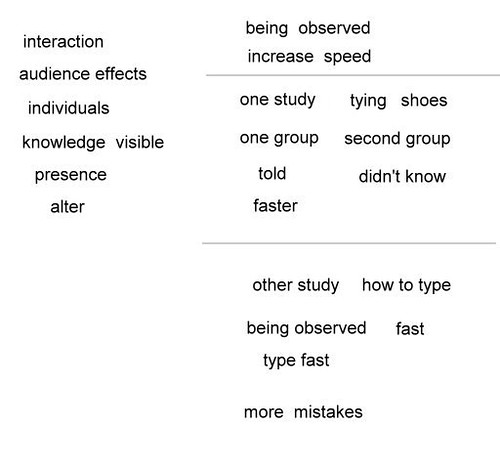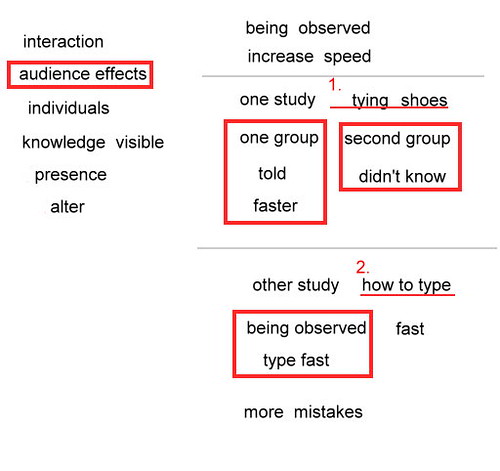這一節談論 no.4 的答題策略
模板:
1 The professor in the lecture is discussing _____.
2 The concept is that _____.
3 First, He mentions _____.
4 He says that _____.
5 Second, the professor mentions_____.
6 He says that _____.
reading part 該做什麼:
我們的reading時的工作no.3時是類似的,
但是不同的是在no.4更偏重理解,reading看懂比較重要,頂多再抄幾個key words.
why?
因為lecture中就有講reading的部份了,這兩的部份是有重疊的。
所以你等會再lecture抄的東西,概念上跟reading是有cover到的,
你可以不用重抄一次...,在讀reading時,我是建議花多點時間在理解上,
因為你不理解lecture等等要講什麼理論,那你等一下有可能聽得很吃力,會遺漏更多資訊。
題目是要求你利用reading與lecture中的例子來解釋xxx concept(ex. audience effects)
不是要你個別說reading中講了什麼、lecture中講了什麼,
而是要你整合起來講,
所以我們非常有理由可以偷懶!
reading大致取到如下的資訊,就算非常足夠了:
人與人之間會互相影響
audience effect
個人會被影響,改變行為
在no.4 的部份,要特別check reading有沒有提到一下特殊名詞、人名、地名等等,
像OG的例子中,雖然title 是socail interaction,
就在reading末段提出了 audience effects,
而整個lecture都在講audience effects.
如果你偷懶只看前半段而已,就會漏掉了這個重要資訊。
listening part 該做什麼:
taking note~
supporting detail只要足夠就好了,不用完全的聽寫下來。
但我還是建議你,為了完整性、以及任何不備之需盡量的寫下來。
在這邊note taking的技巧大致上是跟聽力測驗時討論的一樣的。
我的經驗中,似乎在lecture最後的地方,也就是教授講完實驗、例子之後,
教授會下結論!
我不是100%的確定,因為我沒有考過很多很多次,但我有遇到過。
在這個OG例子中,就是教授說「學習新的技巧時,最好獨自練習」,
有很多人,都會漏掉了這個結論,
然後,很可能因為這樣,ETS就給你個評分Fair,理由為:漏掉一些重點...
在左半邊是reading時寫的note,
在右半邊是conversation時寫的note,
沒聽懂的話,還是要抄下你聽得懂的單字,這樣你還可以造句。
接下來,我們的工作是組織內容,
工作很簡單,就是畫圈圈、標號。
接者,我們就可以套用模板了。
下面是個簡單、文法結構不複雜的成品。
別忘記,先深呼吸一下,再不急不緩的說唷~
The professor in the lecture is discussing audience effects.
The concept of audience effects is that when people are observed, they would change their behavior.
First, He mentions tying shoes.
He says that two groups of people are asked to tie their shoes.
One group is told they will be observed, and the other isn't.
The people who know they're being observed tie their shoes faster than the other.
Second, the professor mentions learning how to type.
when people are told to be observed, they type faster.
However, they make more mistakes.
The professor suggests that people would practice new activities along for decreasing mistakes.
同樣的,也來一篇比較"炫技"'、需要較多控制力的成品:
(目的是讓你知道,speaking仍有可以進步的空間)
The concept of audience effects shows that people's actions are influenced, when they're observed by other people.
The professor continues to give a couple of experiments to support the reading passage.
The first experiment is tying shoes.
In this experiment, there are two groups.
One is told to be observed, but the other doesn't.
The result demonstrates the audience effects which shows the observed group tie the shoes faster than the other one.
The second experiment is learning how to type words.
This experiment shows when knowing being observed, people would type faster and make more errors.
So, finally, the professor sugguets it is better to practice a new activity when you are alone.
如果是教授反駁reading的情況要怎麼說呢:
只要加一段 However, the professor disagrees with the ideas in the reading passage.
ex.
The professor in the lecture is discussing audience effects.
The concept of audience effects is that when people are observed, they would change their behavior.
However, the professor disagrees with the ideas in the reading passage.
時間控制:
no.4 這題有1分鐘的說話時間。
大約的劃分如下
15秒 介紹主題、說明lecture (1, 2 句)
20秒 first reason (3, 4 句)
25秒 second reason (5, 6 句)
一樣,我習慣以35秒來做分界,
差不多35秒的時候,就要提醒自己要切到 second reason去了。




 留言列表
留言列表